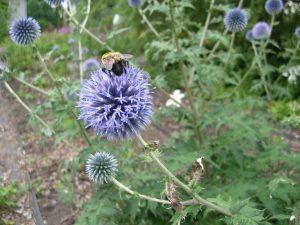Colony collapse and bee decline threaten our food supply. Bees, both bees (about 4000 kinds world-wide) and honey bees, depend on nectar from flowers for food. In turn we humans depend on bees to pollinate flowering plants for much of our food and for the beauty of our gardens. Bees don’t purposefully pollinate flowers. While collecting nectar they rub past pollen and it sticks to them, like cockleburs to dogs. When they fly to the next plant the pollen rubs off on the stigma fertilizing the plant.
How You Can Help Save Bees
Experts attribute the decline to use of insecticides and less nectar for bees by urbanization, and by rural monoculture such as large fields of wheat, corn, rye, barley, or oats, all pollinated by wind, not by bees. We can reduce or eliminate insecticide use and plant flowers to feed bees and incidentally make gorgeous gardens. Or, plant flowers to make gorgeous gardens and incidentally feed bees.
such as large fields of wheat, corn, rye, barley, or oats, all pollinated by wind, not by bees. We can reduce or eliminate insecticide use and plant flowers to feed bees and incidentally make gorgeous gardens. Or, plant flowers to make gorgeous gardens and incidentally feed bees.
Fewer plants bloom in spring and fall, the most critical times for feeding bees. In spring bees have been without nectar for months and in fall they need to get ready for winter (in our northern places.) Not all flowers provide nectar or pollen, in particular flowers with double petals and some hybrids. People talk about native plants for native creatures but honey bees are native to Europe, introduced by early colonists. Aren’t we glad for this alien? Here’s a list of plants that do provide pollen and nectar for these essential seasons.
SPRING flowering plants:
Perennials
Bergenia cordifolia Pigsqueak
Brunnera macrophylla Siberian bugloss
Buxus microphylla ‘Koreana’
Clematis integrifolia Solitary clematis
Convallaria majalis Lily-of-the-valley
Dandelion & clover (here’s your chance to stop applying weed & feed to the lawn)
Dicentra eximia Fern-leaf bleedingheart
Dodecatheon meadia Shooting star
Euphorbia polychroma Cushion spurge
Geum triflorum Prairie smoke
Helleborus –all
Iris versicolor Blue flag
Lupinus perennis Lupin
Mertensia virginica Virginia Bluebells
Nepeta mussinii Catmint
Papaver anomalum Alpine poppy
Papaver orientale Oriental poppy
Primula veris Cow slip
Primula vulgaris English primrose
Pulmonaria angustifolia Blue cowslip
Pulsatilla (Anemone) patens Eastern pasque flower
Pulsatilla (Anemone) vulgaris Pasque flower
Tiarella cordifolia Foam flower
Bulbs
Crocus
Hyacinth & Grape hyacinth
Species tulips
Scilla
Snowdrop
Trees and Shrubs
Aronia arbutifolia Rec chokeberry
Aesculus pavia Red buckeye
Cercis canadensis Red bud
Cotoneaster multiflorus Showy cotoneaster
Fothergilla gardenia Fothergilla
Hamamelis vernalis Witch hazel
Magnolia virginiana Sweetbay magnolia
Mahonia aquifolium Oregon grape
Myrica pennsylvanica Northern bayberry
Ribes aureum Clove currant
Salix discolor Pussy willow
Syringa vulgaris Lilac
Fall Flowering plants
Perennials
Aster divaricatus White wood aster
Aster novae angliae New England aster
Boltonia asteroides Bolton’s aster
Calamintha nepeta ssp. nepeta Lesser calamint
Campanula rotundifolia Harebell
Ceratostigma plumbaginoides Leadwort
Chelone glabra White turtlehead
Clematis paniculata Sweet autumn clematis
Clematis tangutica Russian virgin bower
Eupatorium coelestinum Blue mist
Gaillardia aristata Blanket flower
Liatris aspera Rough blazing star
Lobelia siphilitica Blue cardinal flower
Rudbeckia subtomentosa Sweet black-eyed susan
Rudbeckia triloba Brown-eyed susan
Ruellia humilis Prairie petuna
Sedum ‘Autumn Joy’
Solidago – all Goldenrods
Tricyrtis hirta Toad lily
Annuals
Verbena bonariensis (not hardy in Z 5 so treat as annual)
Single petal Zinnias
Shrubs & trees
Heptacodium miconiodes Seven son flower
